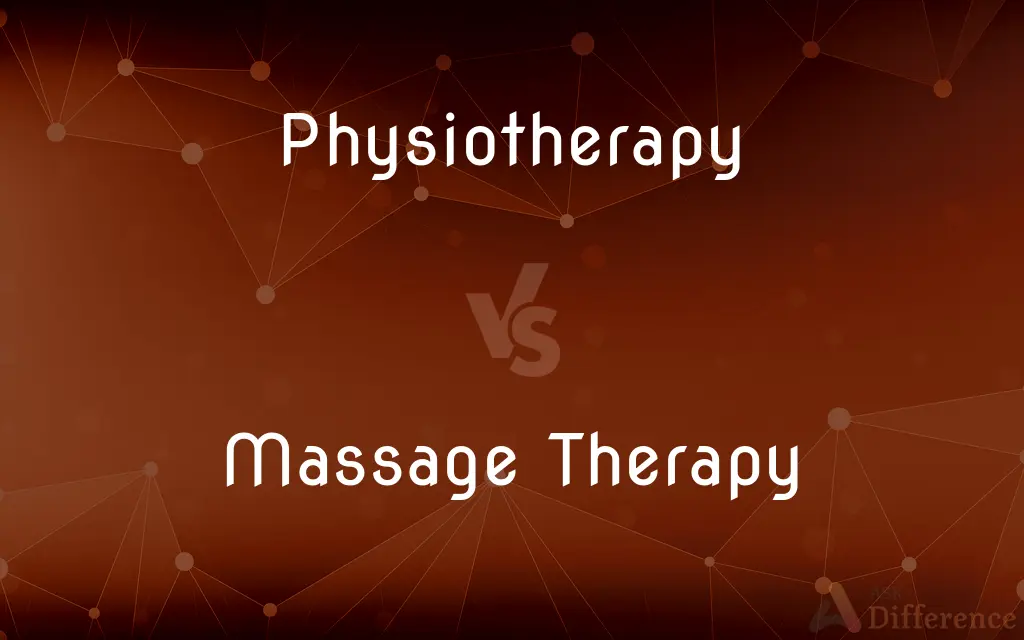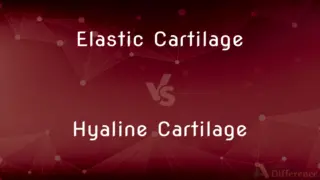Physiotherapy vs. Massage Therapy — What's the Difference?
Edited by Tayyaba Rehman — By Fiza Rafique — Published on March 24, 2024
Physiotherapy is a healthcare profession focused on diagnosing, treating, and preventing physical impairments, while Massage Therapy is a technique-oriented approach primarily aimed at relieving muscle tension and stress.

Difference Between Physiotherapy and Massage Therapy
Table of Contents
ADVERTISEMENT
Key Differences
Physiotherapy encompasses a wide range of treatments and interventions aimed at restoring, maintaining, and maximizing a patient's mobility, function, and well-being. It involves assessment, diagnosis, and a personalized treatment plan that may include exercises, manual therapy, and the use of technological equipment to address specific physical issues. Physiotherapists work with patients of all ages dealing with injuries, disabilities, or health conditions that affect physical function.
Massage Therapy, on the other hand, focuses on manipulating the body's soft tissues, including muscles, connective tissues, tendons, ligaments, and joints, to alleviate discomfort associated with everyday stress, muscular overuse, and many chronic pain syndromes. Massage therapists use various techniques to enhance muscle relaxation, improve circulation, and promote overall wellness, making it an effective treatment for reducing stress and physical tension.
Both professions aim to improve the patient's physical condition, while physiotherapy is more comprehensive and medically oriented, often involving a broader healthcare team. Massage therapy, while beneficial for a wide range of conditions, is more specialized in its focus on muscle and soft tissue manipulation.
Choosing between physiotherapy and massage therapy depends on the individual's specific health needs. For rehabilitation or addressing specific physical health issues, physiotherapy may be the recommended approach. For relieving muscle tension, stress, and promoting relaxation, massage therapy could be more beneficial.
Comparison Chart
Focus
Restoring and maintaining mobility and physical function
Relieving muscle tension and promoting relaxation
ADVERTISEMENT
Techniques
Exercises, manual therapy, electrotherapy
Hands-on manipulation of soft tissues
Conditions Treated
Injuries, disabilities, chronic conditions
Stress, muscle tension, some chronic pain conditions
Professional Training
Extensive medical training, including diagnosis and treatment planning
Specialized training in massage techniques and anatomy
Goal
Rehabilitation and functional improvement
Wellness and relaxation
Compare with Definitions
Physiotherapy
A healthcare profession aimed at the physical rehabilitation of patients.
After her surgery, she underwent physiotherapy to regain full knee function.
Massage Therapy
Utilizes various hands-on techniques.
The massage therapist used deep tissue techniques to address her muscle knots.
Physiotherapy
Uses exercises and equipment to improve mobility.
The physiotherapy plan included specific exercises for strengthening the back muscles.
Massage Therapy
Focuses on relieving muscle tension and stress.
Regular massage therapy sessions have helped reduce her stress levels significantly.
Physiotherapy
Focuses on functional improvement.
Through physiotherapy, he was able to improve his balance and prevent falls.
Massage Therapy
A practice of manipulating body tissues for relaxation and healing.
She received massage therapy to relieve the tension in her shoulders.
Physiotherapy
Involves assessment and treatment of physical issues.
The physiotherapist assessed his condition and devised a customized treatment plan.
Massage Therapy
Can aid in improving circulation and overall wellness.
Massage therapy not only eased his muscle pain but also improved his circulation.
Physiotherapy
Can help with chronic conditions and disabilities.
Physiotherapy has been crucial in managing her chronic arthritis pain.
Massage Therapy
Often used for wellness and relaxation.
They booked a couple’s massage therapy session for a relaxing weekend.
Physiotherapy
See physical therapy.
Physiotherapy
Therapy that uses physical techniques such as massage, ultrasound, heat, and exercise.
Physiotherapy
Therapy that uses physical agents: exercise and massage and other modalities
Common Curiosities
Is physiotherapy only for injury recovery?
While injury recovery is a significant part of physiotherapy, it also addresses chronic conditions, disabilities, and preventive health care.
How often should one undergo massage therapy?
The frequency of massage therapy sessions can vary based on individual needs, ranging from weekly sessions for specific issues to less frequent visits for general wellness.
Can massage therapy help with chronic pain?
Yes, massage therapy can be effective in managing certain types of chronic pain by relieving muscle tension and improving circulation.
What is the difference in the treatment approach between physiotherapy and massage therapy?
Physiotherapy’s approach is more holistic and medically oriented, targeting overall physical function and rehabilitation, while massage therapy specifically focuses on muscle and soft tissue manipulation for relief and relaxation.
What qualifications do physiotherapists have?
Physiotherapists have a degree in physiotherapy and are often required to be licensed practitioners, with comprehensive training in anatomy, physiology, and medical conditions.
How long does it take to see results from massage therapy or physiotherapy?
The time to see results can vary widely based on the individual's condition, the severity of the issue, and the specific treatment goals, with some patients experiencing relief immediately, while others may notice improvements over weeks or months of consistent treatment.
Can massage therapy be part of a physiotherapy treatment plan?
Yes, massage techniques can be incorporated into physiotherapy treatment plans to aid in muscle relaxation and pain relief.
Are physiotherapy treatments covered by insurance?
Many insurance plans cover physiotherapy treatments, especially when prescribed by a doctor, whereas massage therapy coverage can vary.
Can anyone perform massage therapy or physiotherapy?
No, both require specific training and qualifications, with physiotherapists needing a degree and licensure, and massage therapists requiring certification in massage techniques.
Is physiotherapy effective for all ages?
Yes, physiotherapy can be tailored to treat patients of all ages, from children to the elderly, depending on their specific health needs.
Share Your Discovery

Previous Comparison
Collectivist Culture vs. Individualistic Culture
Next Comparison
Elastic Cartilage vs. Hyaline CartilageAuthor Spotlight
Written by
Fiza RafiqueFiza Rafique is a skilled content writer at AskDifference.com, where she meticulously refines and enhances written pieces. Drawing from her vast editorial expertise, Fiza ensures clarity, accuracy, and precision in every article. Passionate about language, she continually seeks to elevate the quality of content for readers worldwide.
Edited by
Tayyaba RehmanTayyaba Rehman is a distinguished writer, currently serving as a primary contributor to askdifference.com. As a researcher in semantics and etymology, Tayyaba's passion for the complexity of languages and their distinctions has found a perfect home on the platform. Tayyaba delves into the intricacies of language, distinguishing between commonly confused words and phrases, thereby providing clarity for readers worldwide.
















































